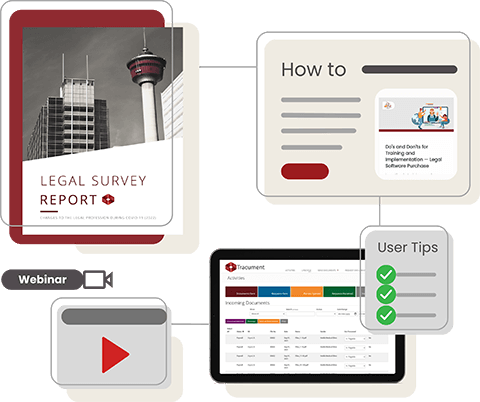
From Classroom to Boardroom: Insights from DeGroote's Case Competition
On March 14, 2025, the DeGroote Entrepreneurship Club (DEC) at McMaster University hosted a case competition named the Boardroom. This event provided students with a unique opportunity to tackle real-world business challenges, bridging the gap between academic theory and practical application. Tracument was honored to have been invited to judge such an event and to have the opportunity to listen and give insight into the world's future business leaders.
The Pitch
The challenge we presented to the participants was this: Tracument has built a strong base of satisfied clients, particularly among legal and healthcare professionals. However, despite this high level of satisfaction, we receive relatively few referrals. As a small business, how can we increase referrals and generate more leads?
Tracument faces three key challenges when it comes to referrals:
1. Engaging the Right People
For a successful referral system within a law firm, healthcare clinic, or hospital, Tracument must appeal to both clerks/administrative staff and decision-makers.
- Clerks and Administrative Staff: These individuals use the software daily and are the most likely to advocate for it. They can vouch for its effectiveness but do not have the authority to bring it into the organization.
- Decision-Makers: Lawyers, doctors, and operations managers are the ones who approve and implement new software. However, they are often difficult to reach due to time constraints and may not prioritize software discussions, even if it benefits their staff.
The challenge lies in bridging the gap between these two groups.
2. Incentives
Incentives are arguably one of the most important parts of a referral program, but what incentives can be offered to motivate both lawyers and clerks to actively refer Tracument? While clerks may enjoy more financial incentives such as gift cards, and experiences, legal staff in senior positions may not be interested in such gifts. Successful referral programs often provide immediate, practical rewards. For example, Uber offers a $20 credit to both the referrer and the new user. However, this model does not translate well to Tracument's business. Instead, we need a tailored incentive system that appeals to both clerks and decision-makers.
3. Structuring Effective Incentives
Additionally, the timing of incentives is crucial. Should we reward referrals immediately, risking that new clients do not fully commit to using the software? Or should we wait until they convert, potentially reducing the perceived value of the reward? Striking the right balance between immediate gratification and long-term impact will be essential for maximizing referrals.
We turned to these students to hear their ideas, and they did not disappoint.
Standout Pitches & Winning Ideas
Several presentations stood out for their creativity, viability, and market potential. Among them:
- VTGC: Their proposal for a double-sided referral program was both innovative and strategic, targeting high-value referrers — those product champions who have the most influence. They offered a tailored incentive plan that included continuing education credits (CPD hours) for legal professionals, adding real value to the program. What stood out was their detailed four-phase plan, which included comprehensive customer research, highly targeted marketing campaigns, conference outreach, and continuous engagement. The incorporation of real-time tracking and quarterly re-engagement campaigns ensures sustainability and consistent momentum, making this referral program not only effective but also adaptable to future needs.
- BOOST: Their presentation provided a fresh and insightful approach to bridging the communication gap between clerks and lawyers within the framework of Tracument's referral program. The team proposed the creation of targeted materials designed to help clerks present Tracument's value proposition effectively to lawyers. What made their pitch truly stand out was the multi-tiered referral structure, offering incentives across different professional levels. Charitable donations added a layer of social responsibility, further boosting engagement. This holistic approach not only encouraged buy-in at every level but also amplified Tracument's presence and adoption within the legal community.
- JASH: They captivated the audience right from the start by visually illustrating the problem, which made the issue more relatable and engaging. Their analysis of various solutions led them to propose the TRAC Plan, a creative and structured approach to incentivizing action. Their model was designed to provide recognition across three distinct levels, ensuring that each participant received a sense of accomplishment and acknowledgment. By focusing on building credibility, reinforcing proactive behavior, and offering tangible rewards, their strategy highlighted the importance of motivation and reinforcement, which would drive both long-term participation and results.
Final Thoughts
It was so encouraging to see so many bright minds in one place where McMaster is slowly helping these students thrive. Whether they walked away with a trophy or not, we hope that every participant gained something invaluable — experience, confidence, and even some connections that will help shape their future careers.
For those who missed it this year, don't worry — next year Boardroom will be one to watch! Until then, keep innovating, keep pitching, and keep building the businesses of tomorrow!
You may also like
Technology Shaping Firm Growth
December 1, 2025
Discover how legal tech boosts firm growth, cuts costs, reduces turnover, and drives success in 2025. Take our survey today!
What Great Training Looks Like in 2025
November 17, 2025
Discover the 4 keys to effective legal tech training in 2025. See the stats, avoid pitfalls, and share your insights in our latest survey.
Introducing a New Way to View Your Matters in Tracument
November 14, 2025
Tracument will be making a release this weekend with some new enhanced features. Our CEO, David Swadden gives a quick run-through about what to expect on Monday.





